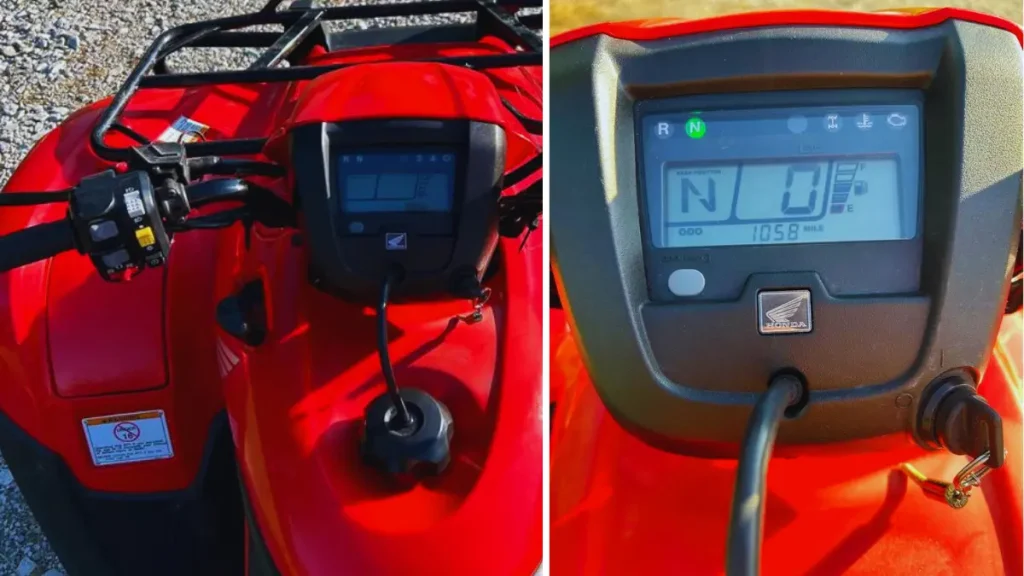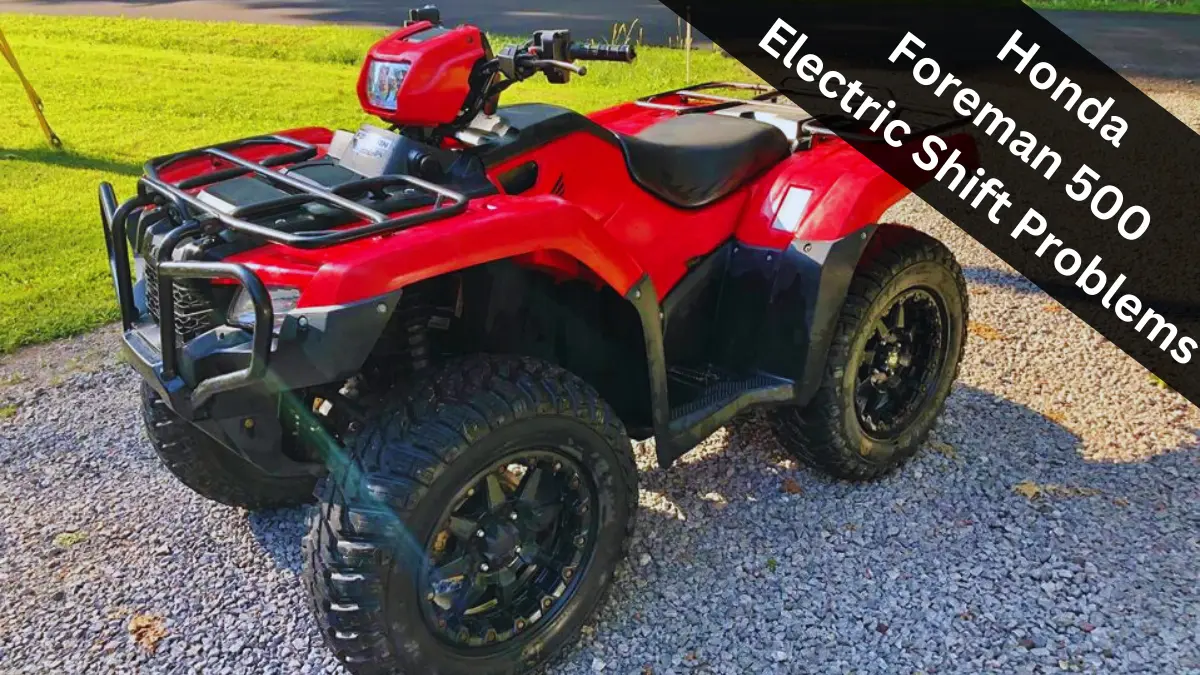Though the Honda Foreman 500 ES won’t make the list of today’s best ATVs for the money, during its heyday it was near the top of the list.
And while these models hold up well, there is one major problem that many will experience as an owner of these machines.
The electric shift buttons have a tendency to stop working over time.
This guide will explore the following around these electric shift problems:
- What happens when the electric shift stops working
- Three main causes of the electric shift not working
- How to fix the electric shift and get it working again
Symptoms And Causes Of Electric Shift Problems
Most of the time when this problem happens, you’ll push the shift buttons and hear the shift motor attempting the shift, but the shift won’t actually happen.
You should notice your display flashing a “- -” and then the “ESP” indicator flashing multiple times as well.
This is alerting you that there’s an issue with your electric shift, and usually boils down to an issue with one of the following:
- Faulty throttle position sensor
- Faulty shift angle sensor
- Faulty shift motor
Covering your Foreman 500 with one of the best ATV covers will help to prolong the life of these components, whether you park it inside or outside between uses.

Determining The Problem
When these electric shift problems happen with your Foreman 500 and you see the “- -” flash, you should then see the “ESP” flash rapidly a number of times below it on your display.
You’ll need to count these rapid ESP flashes in order to determine what the exact issue is with your ATV, and then refer to your model’s Troubleshooting Guide (see below) to find the problem that correlates with the number of flashes.
The table below is a list of fault codes for 2005 – 2011 Honda Foreman 500 models, which will help you narrow down any problem with your ATV (other years should refer to their owner’s manual for the exact fault code guide).
| Gear Position Indicator Blinks | Part/System To Check |
| #1 | ECM (writing & recording circuit |
| #2 | ES shift switch system (up & down) |
| #3 | Angle sensor system |
| #4 | Gear position switch system |
| #5 | ECM motor driver circuit |
| #6 | ECM fail-safe relay circuit |
| #7 | ECM voltage convert circuit |
| #8 | Angle sensor system |
| #9 | Angle sensor system |
| #10 | CKP sensor system |
| #11 | Rear VS sensor system |
| #12 | Gear position switch system |
| #13 | Throttle position (TP) sensor system |
So if you see the “ESP” flash 13 times on your display, you know you have an issue with your throttle position sensor (TPS).
As mentioned earlier, most of the time you’ll find your issue relates to either the TPS, angle sensor, or shift/ECM motor.
Counting the flashes will point you to which one it is, and the remainder of this guide will explain how to fix each issue.
Faulty Throttle Position Sensor
If your throttle position sensor has gone bad, your ECU will not be able to tell that the throttle is not closed and will not enable a gear shift to take place.
You’ll need to replace it, but there’s more to it than just removing the old one and installing a new one.
You need to be sure that you “pre-load” or “clock” the new throttle position sensor as the new one won’t work properly until you do.
Clocking The Throttle Position Sensor
When installing a new throttle position sensor, you’ll need to clock it and put preload on the sensor in order for it to function properly.
You do this by installing it past where the holes for the bolts that hold it in place line up, pressing it down, and then turning it clockwise until the bolt holes line up.
You’ll know that you’re doing this right if you feel light tension on the sensor as you turn it clockwise towards the bolt holes.
Depending on the year of your Foreman 500, the position of your throttle position sensor should be similar to that of your angle sensor.
Generally you should start by installing it around the “3 o’clock” position, then rotate it counter clockwise a quarter spin until you get to the “6 o’clock” position and then bolt it in place.
Faulty Angle Sensor
The angle sensor is responsible for providing a voltage and speed signal to the ECU in your Foreman 500.
This signal controls the shift motor so it knows that the transmission has shifted gears.
When the angle sensor goes bad, the ECU won’t know your Foreman has shifted gears even though the shift motor has been sent the signal to make a shift.
This results in the ECU thinking your ATV is stuck between gears, and you get the error code on your display.
When this happens, you’ll need to replace your angle sensor. But like the throttle position sensor, you can’t just throw in a new unit and be on your way.
Installing The New Angle Sensor
There are four steps you’ll need to take to properly remove and install a new angle sensor:
- Locate the angle sensor and remove it
- Install the new sensor
- Spring load the new sensor
- Sync the new sensor with your ECU
Honda Foreman 500 Angle Sensor Location
Your angle sensor is going to be located on the left side of the Honda Foreman 500 in your engine compartment just below the seat.
You’ll need to remove the seat and some of the plastics to access it. The angle sensor plugs into a plate that is attached via two bolts.
Replacing The Angle Sensor
You’ll need to remove the angle sensor and the plate it attaches to in order to replace it with a new one properly.
There are two Allen screws that hold the plate in place, which you’ll need to remove.
You’ll then need to reinstall the plate and new angle sensor via those same screws, but you have to spring load the angle sensor and plate when reinstalling.
Spring Loading The Angle Sensor
Similar to the throttle position sensor, you’ll need to spring load the new angle sensor or it will not work correctly.
If you’ve installed a new angle sensor and are still getting an error code when you go to use the electric shift buttons, you can be pretty certain you’ve not spring loaded the new sensor when installing.
To spring load the new sensor properly while installing it, turn the sensor and plate about a quarter of a turn counter clockwise to the where the Allen screw holes would normally match up.
Then push in the plate, hold it tight, and turn it back clockwise until the Allen screw holes match up properly.
You should feel some slight tension from the spring inside while doing this, which indicates you are spring loading it properly.
Depending on the year of your Foreman 500, many times you’ll need to start this process with the sensor plate in the “three o’clock” position and turn it clockwise to the “six o’clock position”.
Once you’ve done this and the screw holes align, go ahead and screw it into place to reattach it.
But you’re still not quite done, as you’ll now need to sync your ECU with the new sensor.
Syncing The ECU With The Angle Sensor
To ensure your new sensor can communicate with your ECU and work properly, you’ll need to sync the two following the steps below:
Pro Tip: country music fans can turn on Morgan Wallen’s “Up Down” for further assistance (you’ll see why soon).
- Start your Foreman and let it idle for 30 seconds while in Neutral
- Shift into the Drive position and be sure the gear shift indicator on your display reflects this by showing a “D”. If it doesn’t, you’ve not installed the sensor properly.
- If “D” displays properly, ride slowly forward a few feet.
- Move it back into Neutral and make sure the display shows “N” or “- -”.
- Cut the engine.
- Move the drive mode select into Auto.
- Turn the ignition switch to ON while pressing both UP and DOWN electric shift arrow buttons at the same time.
- Immediately release both electric shift buttons, then immediately push and release the buttons in this order: UP, DOWN, UP. Release each button after pushing it.
- While doing this, you should hear the control motor adjusting the angle sensor and the display should read “- -”.
- Immediately after doing this, move the throttle lever from the fully closed to fully opened position and then back to fully closed again.
- For the following steps, you should raise your ATV with a stand or jack.
- With the engine still on, ensure the gear shift is in Neutral, the mode select switch is “ESP” and the ATV is in 2WD then cut the ignition off.
- Hold down the UP and DOWN buttons and re-start ignition.
- Check to be sure the gear position indicator displays the “N”.
- Immediately release both the UP and DOWN buttons, then quickly push them again in this order while releasing each one after pushing it: UP, UP, DOWN, DOWN.
- Start your engine and put it in Drive.
- Push the UP electric shift button four times to select 5th speed, being sure that the gear indicator displays “5” and “- -” blinking alternately.
- Slowly throttle and get your wheel speed up to around 20 mph.
- Your gear position indicator should change to display a constant “5” when this step is finished.
- This should complete the process, but test ride your Foreman to ensure all modes and electric shift buttons are working correctly.
Faulty Shift Motor
A faulty shift motor is another common cause of the electric shift not working properly in the Foreman 500.
If your error code points towards an issue with your shift motor, you can either fix it or replace it.
To Fix The Shift Motor
Most of the time when your shift motor stops working right, it’s due to the factory grease on the gears gumming up over time and making the gears stick.
You’ll need to remove your shift motor (located near the angle sensor) completely from the ATV in order to fix it.
When you’ve removed it, inspect the gears for any sign of this gummed up grease and remove it using paint thinner or another solvent.
Once the old grease has been removed, grease the gears with a good bit of White Lithium grease.
Note that you can clean the gears properly without disassembling the shift motor.
Reinstall it once finished.
Replacing The Shift Motor
If you’d prefer to replace the shift motor than go through the trouble of cleaning it, a new one will generally run you between $150 and $200.
You can test your shift motor using a multimeter to determine whether it’s still working.
Final Word
While these electric shift problems in the Foreman 500 are prevalent and concerning, most of the time simply replacing one of the components mentioned above will have your ATV working properly again pretty quickly.
And this issue is not just confined to the Foreman models, as electric shift problems occur in the Honda Rancher 420 as well.


